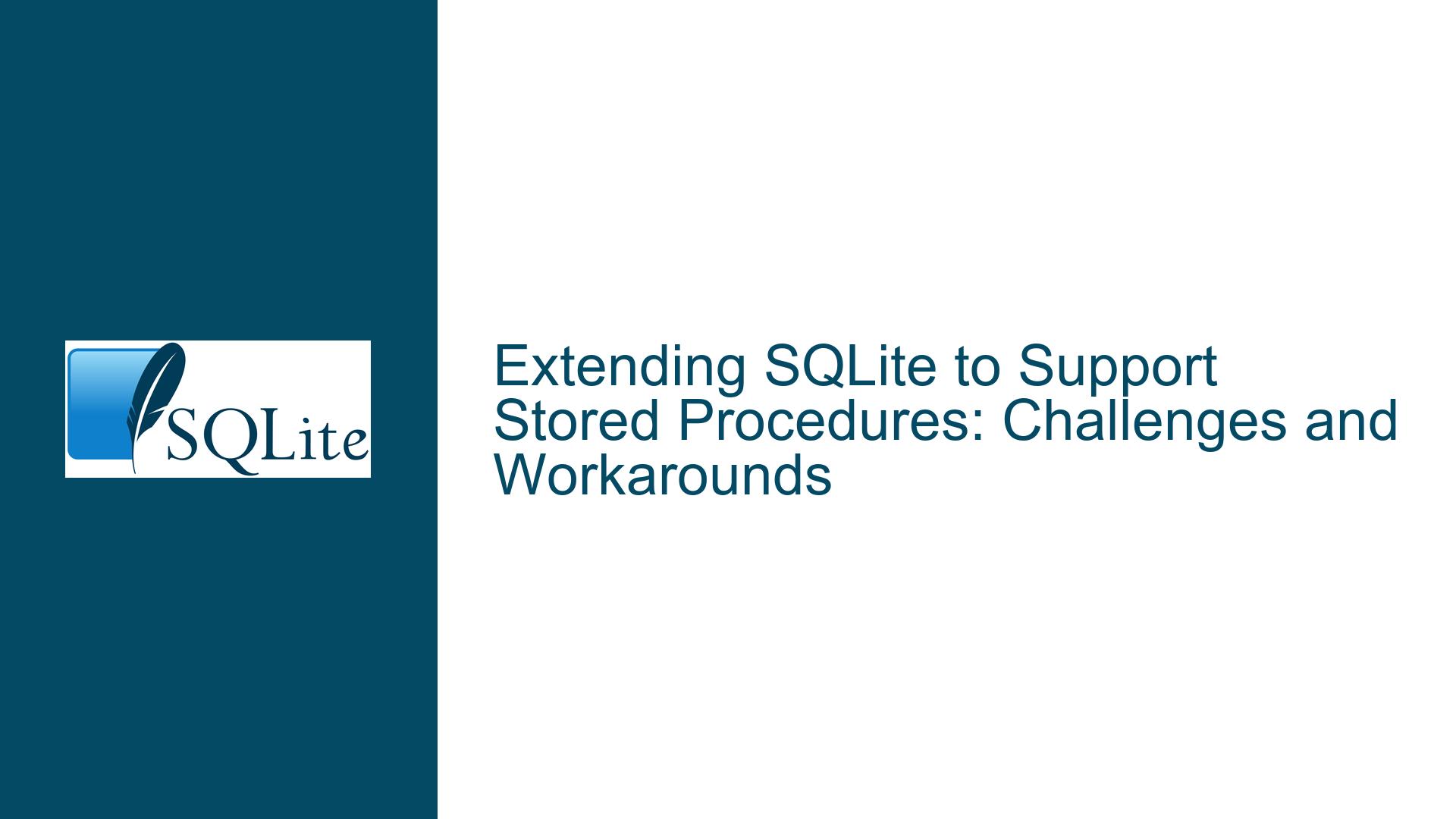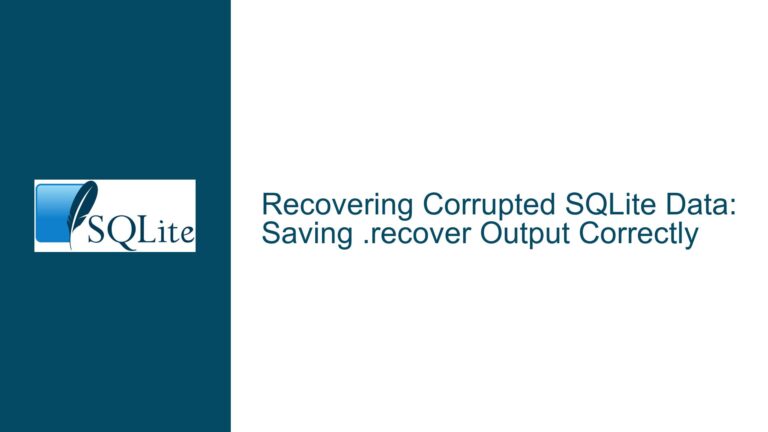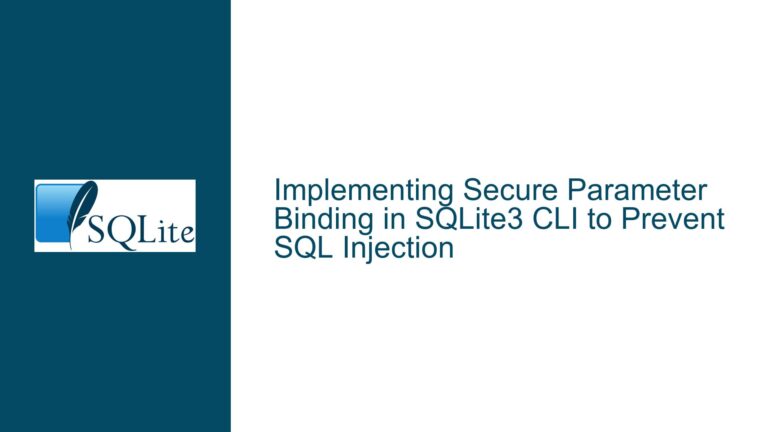Extending SQLite to Support Stored Procedures: Challenges and Workarounds
SQLite’s Lack of Native Stored Procedure Support
SQLite, by design, does not support stored procedures in the traditional sense found in other relational database management systems (RDBMS) like MySQL, PostgreSQL, or SQL Server. This limitation stems from SQLite’s lightweight architecture, which prioritizes simplicity, portability, and minimal resource usage over advanced features like stored procedures. The core SQLite engine does not allow extensions to modify its SQL syntax, which means that adding native stored procedure support is not feasible without altering the core database engine itself.
Stored procedures are typically used to encapsulate complex business logic within the database, allowing for reusable and modular code. They are particularly useful in scenarios where multiple applications or services need to interact with the database in a consistent manner. However, SQLite’s design philosophy emphasizes embedding the database within applications rather than serving as a standalone database server. This design choice means that SQLite relies on the host application to handle complex logic, rather than the database itself.
The absence of stored procedures in SQLite can be a significant limitation for developers who are accustomed to using them in other databases. However, SQLite provides alternative mechanisms to achieve similar functionality, albeit with some trade-offs. Understanding these alternatives and their implications is crucial for developers who need to implement stored procedure-like behavior in SQLite.
Interrupted Write Operations Leading to Index Corruption
One of the primary reasons SQLite does not support stored procedures is its focus on maintaining a simple and robust architecture. SQLite’s design is optimized for embedded systems and applications where reliability and minimal resource usage are paramount. Introducing stored procedures would complicate the database engine, potentially leading to issues such as interrupted write operations and index corruption.
In a traditional RDBMS, stored procedures are executed within the database engine, which manages transactions, locks, and other concurrency control mechanisms. This centralized execution model can lead to complex interactions between stored procedures and the database engine, especially in high-concurrency environments. SQLite, on the other hand, uses a file-based approach where each database is a single file, and transactions are managed at the file level. This simplicity is one of SQLite’s strengths, but it also means that adding stored procedures would require significant changes to the database engine, potentially introducing new failure modes.
For example, if a stored procedure were to perform a series of write operations, and the database were to crash or lose power during execution, the database could be left in an inconsistent state. SQLite’s current transaction model ensures that either all changes in a transaction are committed, or none are, but this model does not easily extend to the execution of stored procedures, which may involve multiple transactions or complex logic.
Furthermore, SQLite’s indexing mechanism is designed to be lightweight and efficient, but it is not well-suited to handling the complex interactions that stored procedures might introduce. Index corruption could occur if a stored procedure were to modify data in a way that conflicts with the indexing strategy, leading to performance degradation or even data loss.
Implementing PRAGMA journal_mode and Database Backup
Given the limitations of SQLite’s architecture, developers who need stored procedure-like functionality must rely on alternative approaches. One such approach is to use SQLite’s PRAGMA statements to configure the database’s behavior and implement manual backup strategies to ensure data integrity.
The PRAGMA statement in SQLite is used to query or modify the internal operations of the SQLite library. One particularly useful PRAGMA setting is journal_mode, which controls how SQLite handles transaction logging. By setting the journal_mode to WAL (Write-Ahead Logging), developers can improve the concurrency and reliability of their SQLite databases. WAL mode allows multiple readers to access the database simultaneously while a single writer is making changes, which can help mitigate some of the issues associated with complex transactions.
However, even with WAL mode enabled, SQLite still does not support stored procedures. To approximate stored procedure behavior, developers can use a combination of prepared statements, triggers, and application-level logic. Prepared statements allow for the execution of parameterized SQL queries, which can be reused multiple times with different parameters. Triggers can be used to automatically execute SQL code in response to specific events, such as inserts, updates, or deletes. By combining these features, developers can create reusable and modular SQL code that approximates the behavior of stored procedures.
Another important consideration is database backup. Since SQLite does not have built-in support for stored procedures, any complex logic that would typically be encapsulated in a stored procedure must be handled by the application. This increases the risk of data corruption or loss if the application crashes or encounters an error. To mitigate this risk, developers should implement robust backup strategies, such as periodic database snapshots or incremental backups. SQLite provides several tools for creating and restoring backups, including the .backup command in the SQLite command-line interface and the sqlite3_backup_init API function.
In addition to these technical considerations, developers should also carefully evaluate whether SQLite is the right choice for their application. While SQLite is an excellent choice for many use cases, its lack of stored procedure support may be a deal-breaker for applications that require complex database logic. In such cases, developers may want to consider alternative databases that do support stored procedures, such as PostgreSQL or MySQL.
In conclusion, while SQLite does not support stored procedures natively, developers can use a combination of PRAGMA settings, prepared statements, triggers, and application-level logic to approximate stored procedure behavior. However, these workarounds come with trade-offs, and developers must carefully consider the implications for data integrity, performance, and maintainability. By understanding these limitations and implementing appropriate safeguards, developers can successfully use SQLite in applications that require complex database logic.






